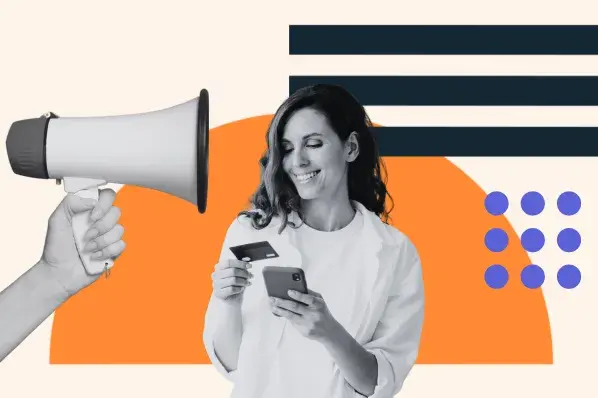I’ll show you both popular and underrated ways to improve average customer acquisition cost from sales experts across industries.
39 Ways to Reduce Customer Acquisition Costs
These tips will cover ways to both lower customer acquisition costs and improve customer lifetime value. Customer acquisition costs and customer lifetime value (CLV) are directly linked — it‘s much cheaper to retain existing customers than to woo new ones. Why acquire customers if you’re just going to lose them next month?
This is a matter of optimized customer profitability, and there are countless ways to improve this. Let's dive into the most effective ways of reducing your customer acquisition cost.
1. Special offers for lapsed customers.
Lower customer acquisition costs by re-engaging lapsed customers through targeted email campaigns and discounts. Sarib Rehman, CEO of Flipcost, leverages this technique for his company.
“We analyze our customer data to identify shoppers who haven't made a purchase in 6 to 12 months and create custom offers to win them back. By reactivating dormant customers, we're acquiring revenue from users we already spent money to acquire for the first time.”
2. Shareable campaigns.
Incentivize social sharing by creating a marketing campaign that incentivizes social shares, like a “share to enter” giveaway. These are particularly popular during the holidays and create a burst of attention on your brand. On lucky occasions, it can also trigger social media virality.
3. Free exposure.
While exposure isn‘t directly tied to sales, consumers almost never make a purchase the first time they learn about a product. New customers need to be exposed to your brand several times before they’re ready to pay, and free exposure can help without depleting any marketing spend.
Free exposure comes in countless forms, and a creative approach is best. Here are a few ideas:
- Branded merchandise (for both you and your team).
- Put your company name on your car.
- Do podcast interviews.
- Free product demos.
- Land earned media.
- Yard signs.
Sarah Blakey, founder of billion-dollar shapewear company Spanx, famously ordered a “SPANX” license plate from the DMV as a way to leverage free exposure. She removed it once people started following her home asking to place order.
4. Time-sensitive discount.
Offer customers a time-sensitive discount to compel them to place an order quickly. I’ve seen these discounts range from 15 minutes to a week. This would be an ideal place for A/B testing your audience.
5. Onboard fast and deep.
In a perfect world, every single new customer would instantly turn into a raving fan and brand advocate (cue the word-of-mouth referrals!). Your best chance at making this happen starts with the onboarding process.
Statistic: Lengthy onboarding processes are a challenge for 40% of sales teams.
Amanda Reineke, CEO of NoticeNinja, found that the faster new clients implement NoticeNinja's software solution, the sooner they realize ROI.
"The more deeply clients leverage our platform, the higher their renewal and expansion rates,“ Amanda Reineke shared. ”We provide ongoing education through monthly newsletters, live training, and an active user community."
This high-touch onboarding approach increased client retention by over 60% in two years.
6. SSL certificate.
If website security feels like an afterthought, then your site may have some unchecked boxes. The most common website security issue I see is a missing SSL certification. Website visitors should be greeted by a lock icon in the left-hand corner of your URL, like the HubSpot URL:

The lock icon communicates to viewers that their connection is private. Sometimes, Google will even block your website by putting up a warning page if your website fails security checks. I recently saw an ecommerce store that was missing its SSL certificate, and I can only imagine how many sales it lost as a result.
HubSpot's website builder includes a free SSL certificate to offer a secure connection.
7. Create content for buyer objections.
Show your target audience that you understand them by creating content that speaks to buyer objections. This will address the elephant in the room, whatever that may be for your offer.
Statistic: Sales reps who successfully defend their product against a buyer's objections can have a close rate as high as 64%.
While content marketing is less conversational than a sales call, your potential customers still have the same objections (even if they don‘t voice them). Content marketing that’s designed to respond to buyer objections will expedite a customer's decision.
Here’s a great example from tights company Sheertex. They claim their tights are indestructible, and then they put it to the test right in front of our eyes, creating loyal customers. Seeing them take a cactus to their product convinced me to try them years ago, and now I recommend these to everyone (seriously, if you’re chronically cold like me, you need these under your jeans all winter.
8. Incentivize reviews and testimonials.
No matter how much energy you put into your marketing strategy, candid reviews from happy customers will always speak louder to potential buyers than the content you‘ve created. That’s the power of social proof.
Statistic: 95% of customers read reviews before making a purchase.
Incentivize readers to leave reviews with a special discount code or promotion. Positive reviews help improve your on-page SEO and can also be shared across social media platforms.
9. Listen to customer feedback.
No one has more valuable insights than your existing customers. Listening to feedback is a superpower in improving customer retention. Collect feedback from existing customers and showcase how you've implemented their ideas, making customers the hero of your brand and positioning yourself as a customer-centric business.
Pro tip: Let your email subscribers or social media followers know how you've been using customer feedback to improve your product. This can help sway potential customers who are still on the fence about purchasing, while nurturing already-paying customers and reducing customer churn.
10. Partnership deals (co-branding).
Who's the peanut butter to your jelly? Find a complementary business and leverage the trust and audience that the other brand has built. You can share audiences, pool resources, and build loyalty. This is also referred to as co-branding. A great example is this campaign between GoPro and Red Bull:
11. Strategic partnerships.
Co-branding is effective for ecommerce brands, but service-based businesses can tap into a similar effect by creating strategic partnerships with complementary businesses. Some examples include:
- A lawn maintenance business partnering with a custom landscaping business.
- A tattoo artist partnering with a piercing artist.
- A copywriter partnering with a web designer.
- A digital marketing agency partnering with a PR firm.
That was the case for digital marketer Ross Plumer, CEO of RJP.design, who saw big payoffs partnering with a local PR firm.
“The PR firm now refers clients needing web services to us, and we refer clients to them for PR and content creation. This symbiotic relationship has generated over $200,000 in new revenue for our companies this year at almost no expense,” Plumer says.
12. Improve customer service.
Remember the link between customer acquisition costs and customer retention? It's never more apparent than when addressing customer service. Focusing exclusively on acquiring customers and then neglecting customer satisfaction and support will lead to high churn rates and increase overall marketing spend.
Statistic: 64% of customers have reported that they‘ll find a new company to purchase from if the company doesn’t have good customer service — no matter how enjoyable the product is.
A customer acquisition strategy alone is unable to improve revenue long-term if your customer lifetime value is low due to poor service.
13. Run A/B tests.
An A/B test (aka a split test) is an effective way of discovering which message is resonating most with viewers and getting the best conversion rates. Consider A/B testing any of these elements:
- Email subject lines.
- Landing pages.
- Paid ads.
- CTAs.
Pro tip: Learn how to run an effective A/B test with our free A/B testing guide.
14. Simple forms.
It‘s natural for some potential customers to have questions about your product or service that aren’t answered on your website. How can they contact you to ask their question? It should be obvious and easy for those individuals to get in touch.
Luo Baishun, CEO and co-founder of HeyForm, recommends simplifying the lead generation process with shorter, more intuitive forms to lower your customer acquisition cost. “Simplifying forms can reduce friction, increase conversion rates, and make it easier for customers to complete them, eventually lowering acquisition costs.”
15. Manage a community or forum.
In a world full of flashy marketing automation and AI bots, I think there's something incredibly valuable to a tangible community. Community is a powerful tool for a brand to leverage, and managing an online community or forum is a powerful way to achieve this.
It nurtures your existing customer base and also serves as a selling point to potential customers. Oftentimes, in these groups, loyal customers become your brand's greatest spokespeople by answering questions and engaging with others.
Statistic: 75% of consumers have reported that they find value in interacting with fellow customers in a brand’s online community.
Here‘s an example that I’ve personally used: a Facebook group for the website builder Elementor, guided by an employee and run by volunteers.
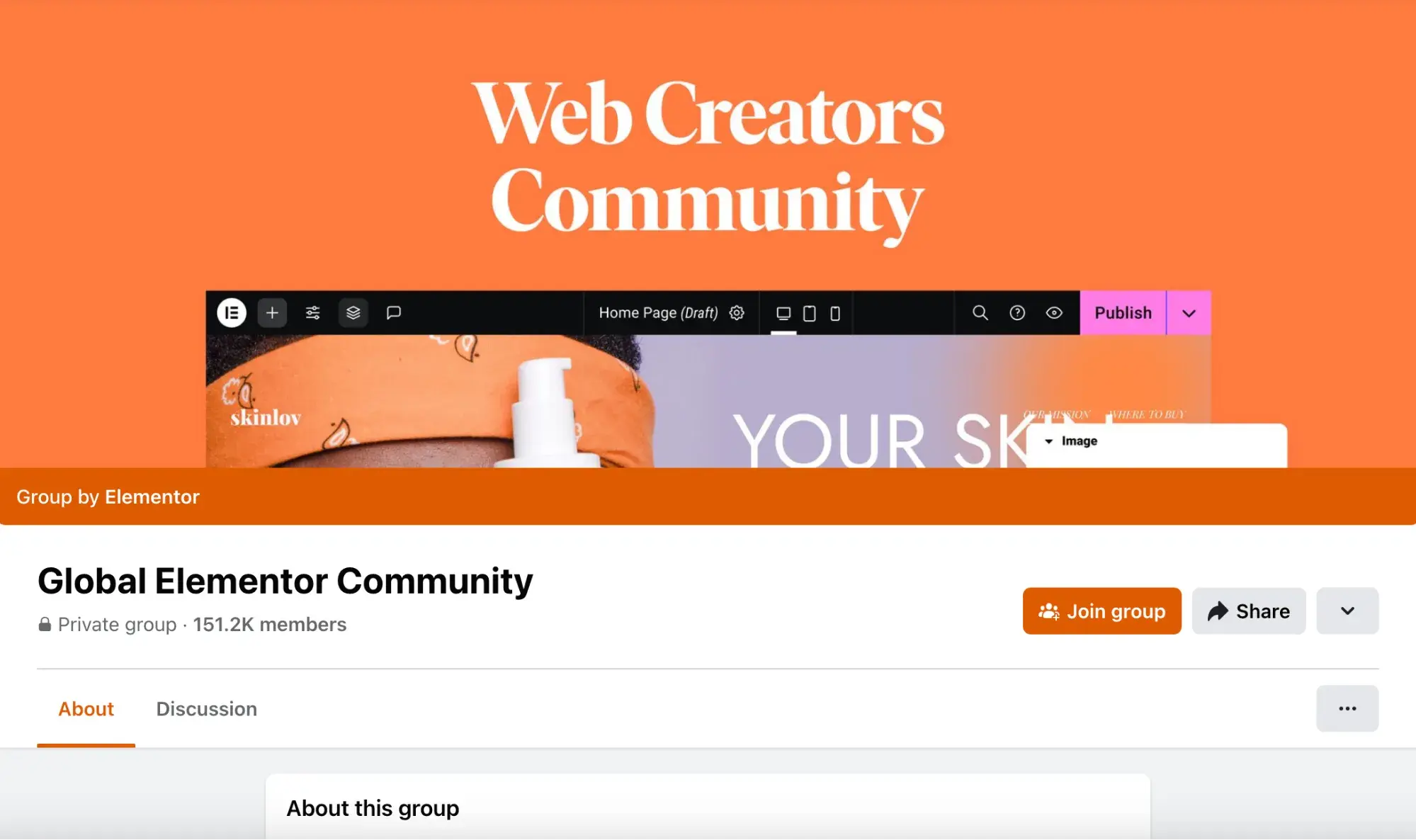
16. Start an affiliate program.
Affiliate programs are staples of the digital marketing world, as they incentivize word-of-mouth marketing. Perfect for ecommerce businesses or any business with an online store, an affiliate program incentivizes recommendations with a percentage of sales.
Pro tip: Affiliate programs are simple to set up and can be leveraged by small businesses with a single product all the way to behemoth brands. Programs are cost effective and it only takes one single affiliate to introduce your brand to their audience and explode your sales.
17. Start a referral program.
A referral program is the same concept as an affiliate program, but I think it's better suited for leads-based businesses. Referral programs tend to bonus customers with a discount or free product instead of a cash payout.

18. Start a loyalty program.
Who remembers the punch card system that used to be a staple of local eateries? With every purchase, the establishment punched a card that you carried in your wallet, and you received a free product when you hit 10 punches. I can still remember the ecstasy of getting a free Auntie Anne's pretzel at the mall.
The modern-day equivalent of the humble punchcard is the discounted subscription model, like this example from Amazon below. This can be hosted on your website, or some retailers have this option built in.
Loyalty programs reward repeat customers in a tangible way, and no marketing strategy is complete without exploring this option.
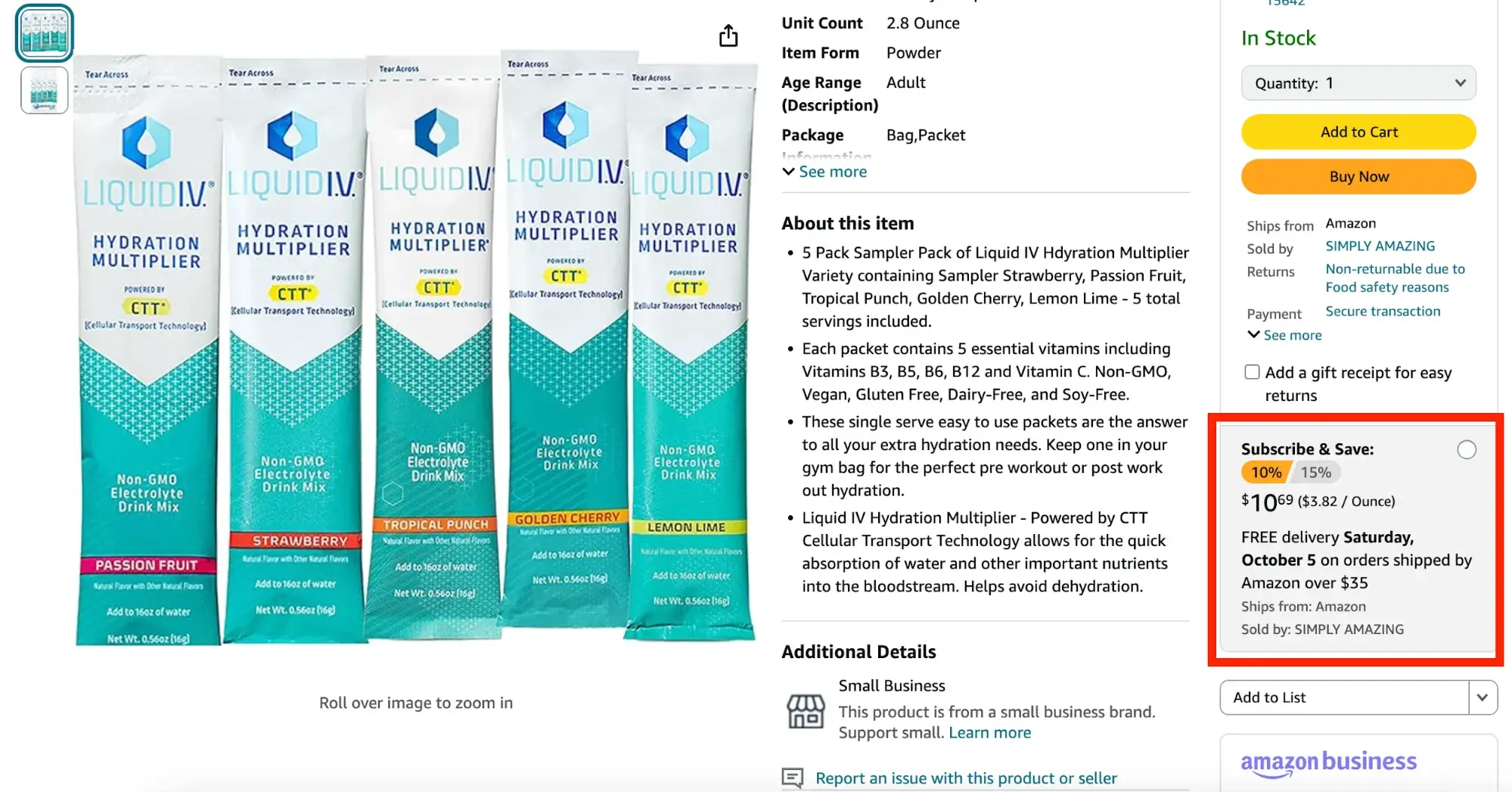
19. Focus on high-quality leads.
One CEO has found that the key to driving down their business's CAC is improving lead quality from the very beginning. “We once experienced high CAC due to poor quality leads from generic trade show lists,” shared Gauri Manglik, CEO and co-founder of Instrumentl.
“By refining our lead generation approach to focus on targeted content syndication and referral programs, we were able to reduce our CAC significantly.”
20. Making existing customers a special offer.
Turn one-time buyers into repeat customers by making them a unique offer. Consider making a special offer to customers who have:
- Purchased from paid media or ads.
- Left positive reviews online.
- Bought a specific product.
Pro tip: Customer segmentation can help greatly with executing this.
21. Offer a new-customer discount.
New customers are naturally hesitant before spending money. Can your product help them more than your competitor? Is your price fair for your product? It's healthy to be picky before investing in a purchase.
A new-customer discount is a popular technique for bringing people off the fence and getting them to convert. This technique turned me into a longtime customer of the brand Boody. I‘d been searching for more climate-conscious closet staples, and Boody kept coming up in searches, but I was hesitant to try. Boody’s first-time customer discount convinced me to give them a try, and I've been a loyal customer ever since.
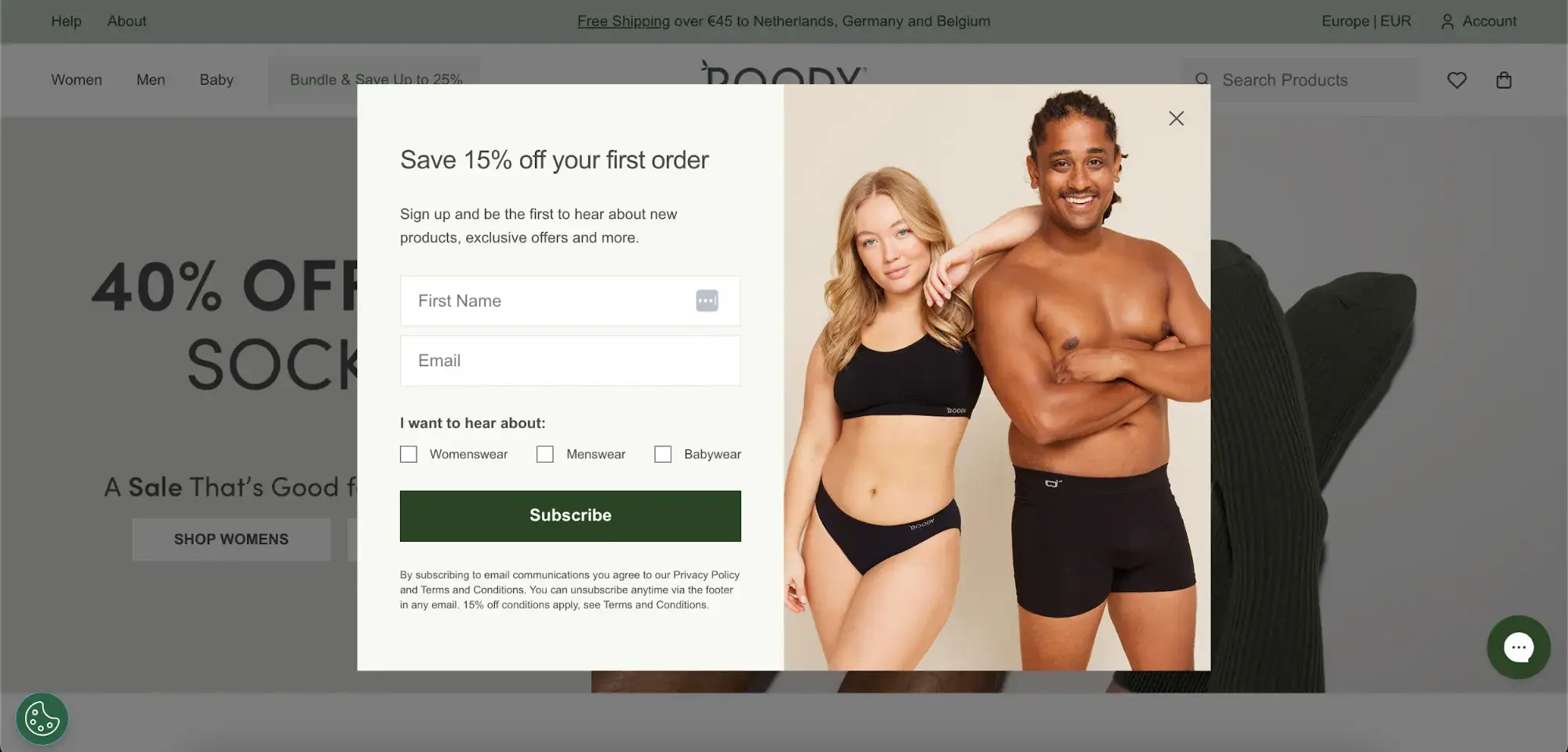
22. Improve product shareability.
Lower customer acquisition costs by creating a product that customers market for you. User-generated content (UGC) is one of the most powerful forms of social media marketing, and wise companies can leverage this without spending money.
Pro tip: You can develop entire marketing campaigns around UGC that boost your existing social presence and bring in new potential customers. Create share-worthy branding and encourage social share on your packaging or digital materials.
A great example is the unicorn company Liquid Death. Founder Mike Cessario told Inc. that his goal was for his water to market itself simply by being photogenic enough that customers would naturally include it in their social media content.
23. Encourage saving content to Pinterest.
When someone shares one of your products on Facebook, some of their Facebook friends will see it. When that person shares the same product link on Pinterest, it can be seen by hundreds or thousands of people. Pinterest is a search engine, and it actually puts more weight on organic content shares than it puts on the content that I manually upload as a Pinterest account manager.
Fun fact: Amazon has never created a single pin on Pinterest, but users have saved so many products to their personal Pinterest boards that Amazon's content has more than 10,000,000 impressions on the platform.
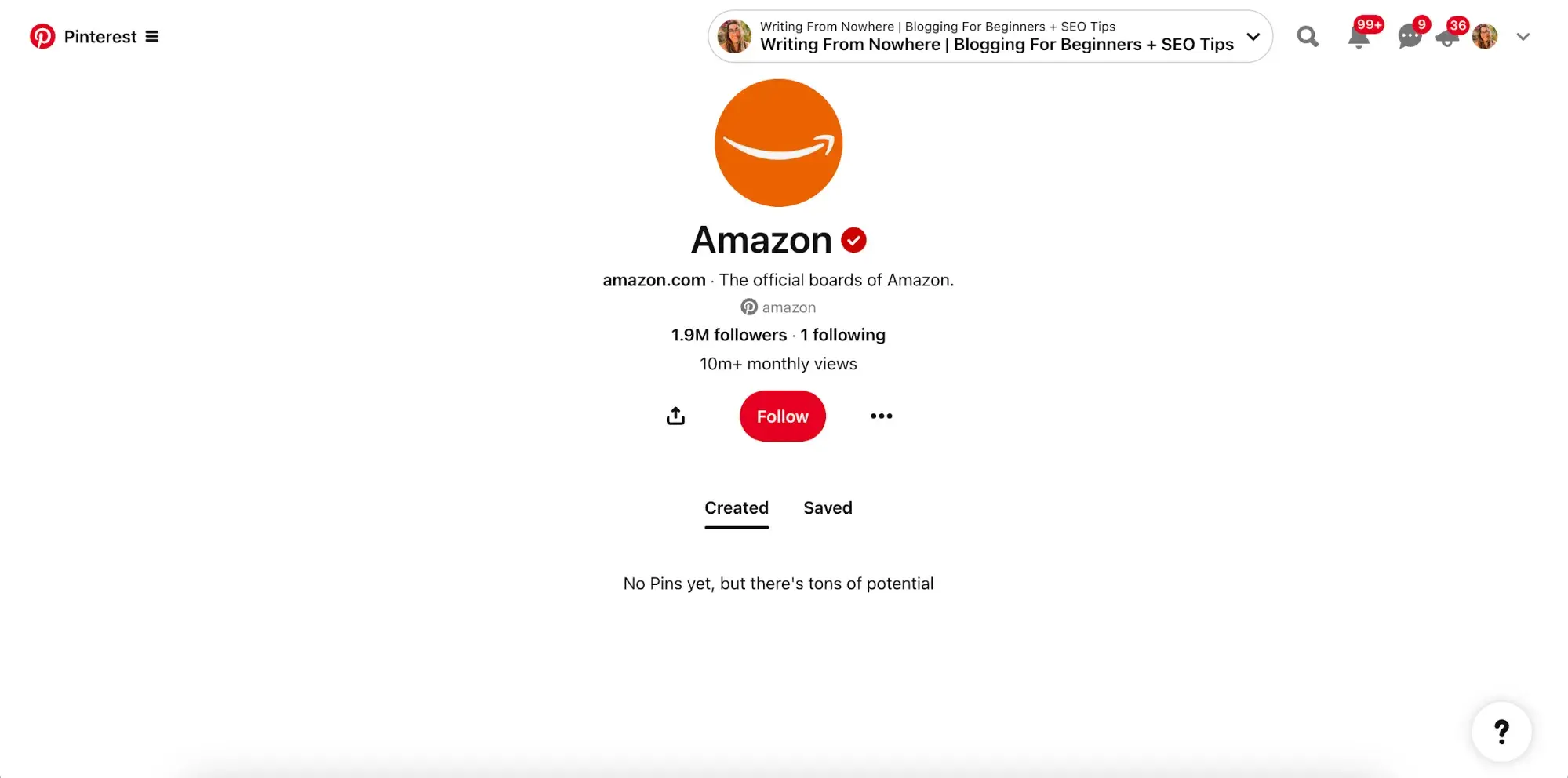
Tap into this by adding a “pin it” button to your website, and make sure you have keyword-rich metadata written for your most important pages. Pinterest will allow users to save any image on your website and it will automatically pull the pin description from your metadata.
See if users are already saving your content to Pinterest without your knowledge by dropping some of your website URLs in Shared Count.
24. Create helpful, search-optimized content.
Every second of every day, people search for solutions and are led to brands that can help them. Take this example below: The electrolyte company Buoy wrote an article answering an FAQ about dehydration. When users read the article, they will hopefully engage with (but at the very least see) the products for sale and the timed pop-up offer inviting them to try Buoy's electrolyte drops.
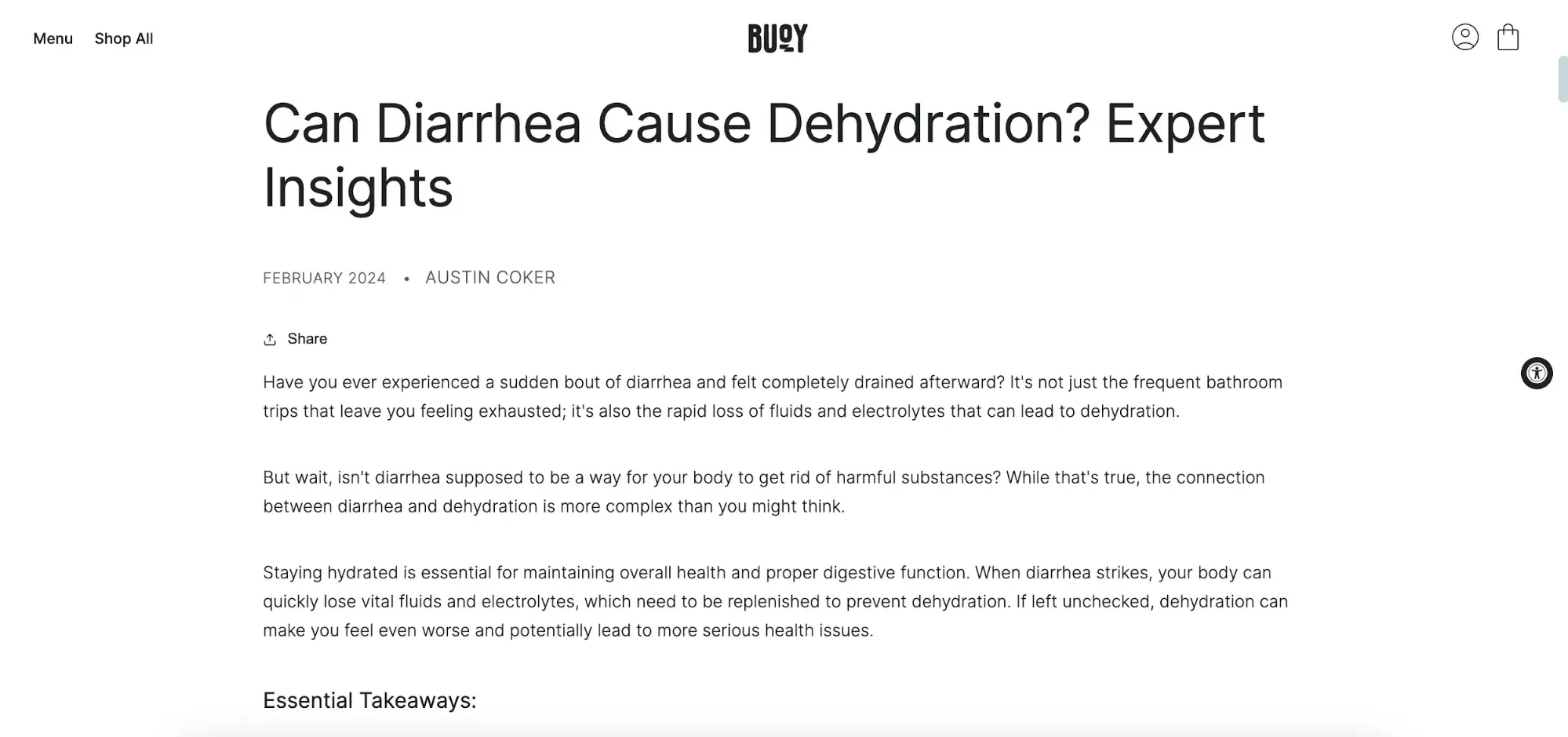
If content like this is optimized correctly for search results, it creates a powerful marketing funnel from search engines into your website. The most popular search engines are Google, YouTube, and Pinterest. This same helpful content approach can be taken with YouTube to earn your brand placement in YouTube's search results.
Pro tip: Don't forget to advertise your product within your blog post or YouTube video; I see this mistake constantly, and your product needs to be visible to search engine viewers to convert.
25. Optimize sales pages.
Beyond producing helpful content that answers questions, you can also optimize your sales pages to appear in search results. Shopping searches are incredibly popular on Google, and most of the pages being displayed appear there organically (but we'll get to paid placement next).
Warning: Optimizing sales pages requires a different touch than optimizing blog content. Your sales team will need to work closely with your SEO team to walk the line between copywriting and optimization.
If you don't have the budget or the content for SEO, then you might find luck in paid ad placement.
26. Run paid ads.
Paid advertising or pay-per-click (PPC) marketing isn't cheap; advertising costs can snowball quickly, but when ads are tested and optimized for conversions, they can have great results for reaching your target audience. Consider any of these popular ad choices:
- Google ads.
- YouTube ads.
- Pinterest ads.
- Facebook ads.
- Instagram ads.
- Website banner ads.
Statistic: Google Ads have the highest return on investment, clocking in at 200% ROI.
27. Identify decision-makers.
When it comes to selling SaaS, one of the best ways to lower customer acquisition costs is figuring out who actually makes the final call on adopting your product.
“A common mistake is assuming the decision-maker is always the highest-ranking person or the one controlling the budget and that adoption follows a top-down process. But in reality, it’s not always that clear-cut — it varies by industry,” shared Vi Trang, growth marketing lead at Rex Software.
“Taking the time to research your audience pays off because you’ll know exactly who to target. That means you’re not wasting budget and resources on the wrong leads, which helps speed up your sales cycle and bring down acquisition costs.”
28. Train all employees for sales conversations.
Every employee at your company gets asked what they do for a living. Their answer can go one of three ways:
- They can say something negative about your company.
- Avoid talking about your company, or…
- Say something positive.
Two of those are a loss: Saying something negative (yikes) and staying silent (aw) both leave money on the table. If your own employees won‘t advocate for your company, who thinks you’re worthy of buying from? Employees should be your biggest advocates, and they should be generating free brand awareness. This is particularly important for businesses with a local target market.
I‘m from Pittsburgh, Pennsylvania, and there’s been a contentious battle between regional healthcare giants going on for years. My mother's a nurse for one of these companies, and she often wears a branded zip-up fleece jacket with the company name on it. She gets asked by strangers for her opinion on the company. What would your employee say about you?
29. Send an abandoned cart email.
There's no more painful feeling for an online store owner than a customer shopping only to abandon their cart. An abandoned cart email is a safety net to help catch some of the missed purchases.
Here's a spit-out-your-water-while-reading example from Liquid Death with the subject line “Maybe you died?”

30. Free trial.
From free software trials all the way to free cheese samples at the grocery store, any product-based business can expand their customer base with free trials of their product. Customers acquired through free trials are positioned to become happy customers because they already see that a product services their needs.
31. Pop-up events.
If you have a product with mass appeal, then you can get great exposure by staging pop-up marketing events. These can be formal pop-ups at trade shows or simple sidewalk demonstrations.
I once remember seeing marketers tie helium-filled balloons to themselves and stand on the sidewalk, encouraging pedestrians to download their free app. This type of in-person marketing can be powerful when leveraged creatively.
32. Detailed product demonstrations.
The sooner you can convince someone to buy from you, the lower your customer acquisition costs will be. Nothing convinces new customers to use your product more than a well-made video demonstration. The more detailed, the better.
Statistic: 82% of surveyed consumers say they've been convinced to buy a service or product by watching a video.
Video demos are often glitzy, energetic, and expensive-looking, but they don't have to be. I love the simple demo from Loom, which is actually made using their own product (and you can make a demo just like this on the free Loom plan).
33. Interactive product demonstrations.
Can you allow users to interact with your product before buying? This can be highly effective at engaging on-the-fence customers without requiring much of their time.
Not every product can offer interactive demonstrations, but it‘s a powerful tool if you’re able to leverage it (especially for SaaS or ecommerce businesses). Here I am trying on Warby Parker glasses virtually. What do you think — can I pull off orange frames?
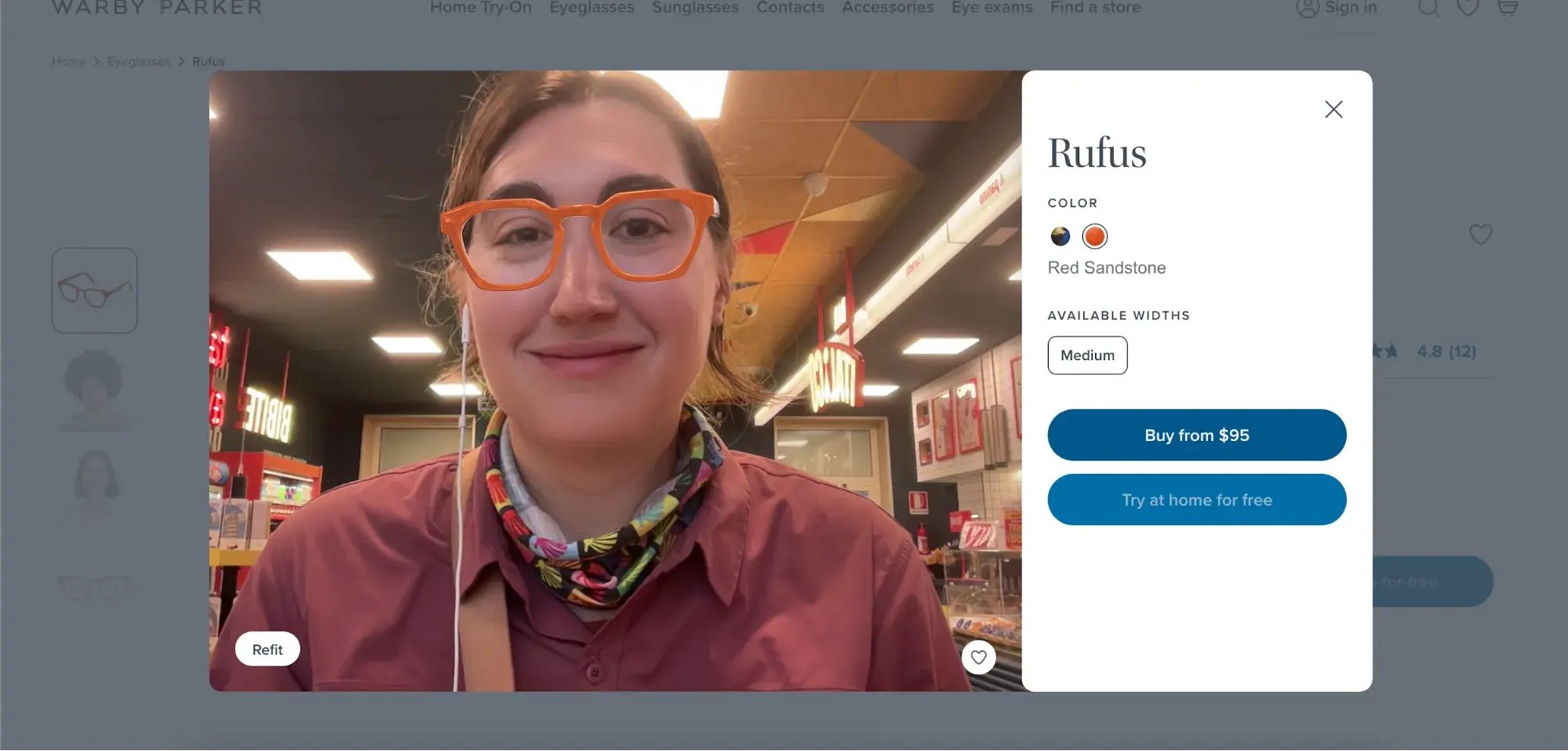
34. Run a retargeting campaign.
Have you ever visited an ecommerce website and immediately noticed ads for that product on social media? No, that wasn't a coincidence. That company is retargeting customers who left their website without making a purchase. Retargeting customers is highly effective at bringing users back into your sales funnel.
Statistic: Research has found that retargeting ads lead to a 1,046% increase in branded search.
These customers are already aware of your brand. They‘ve shown interest, but they’ve failed to convert. Using cookie history, marketing teams work to reel people back into their website after bouncing. Moments after trying on the Warby Parker frames above, I opened up Facebook and saw an ad. Well played, Warby Parker. Well played.
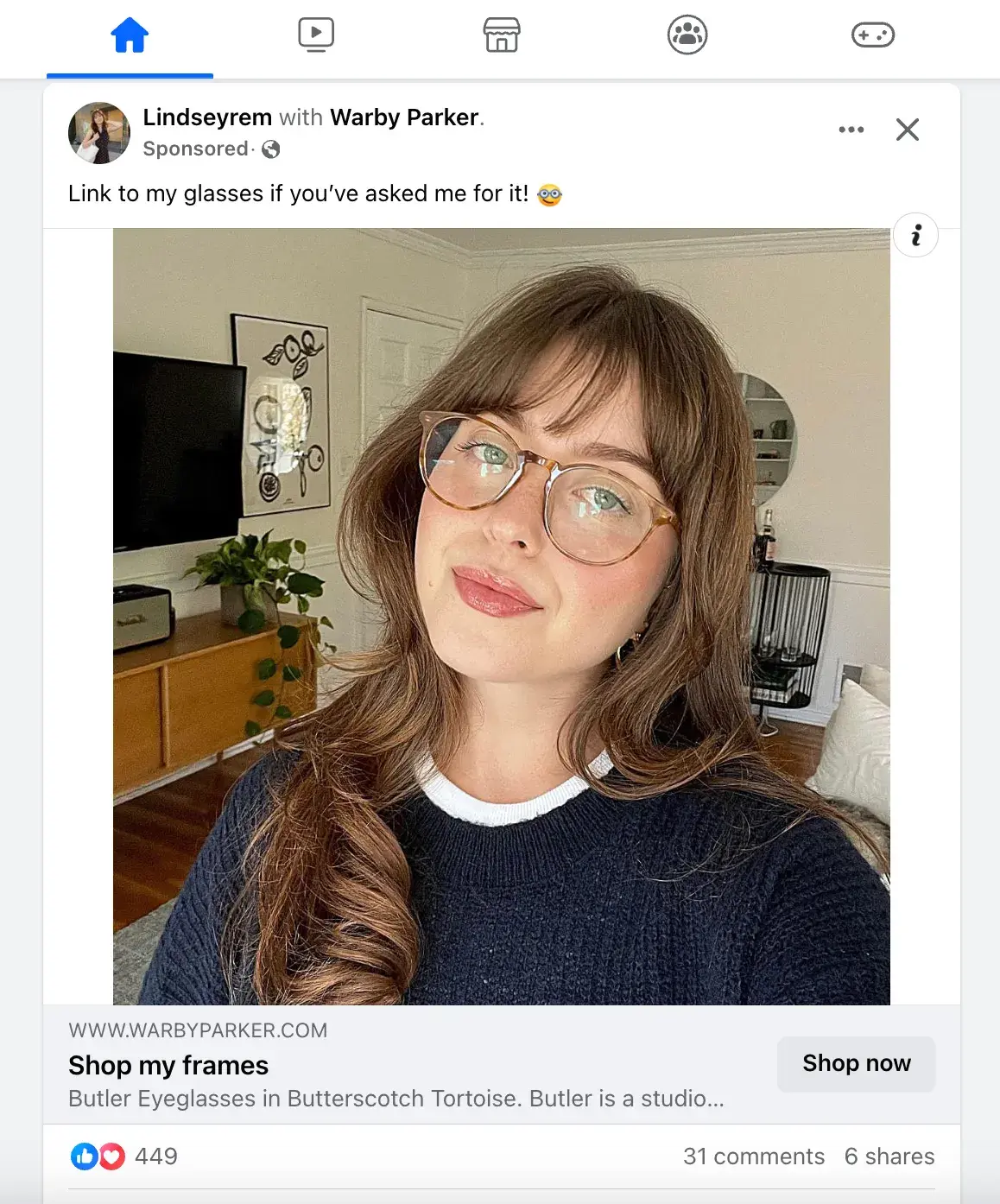
35. Landing page optimization.
The term “optimization” can refer to more than just search optimization — it also refers to optimizing your landing pages for conversion.
Is there a section on your landing page where most viewers close the tab? Where do they spend most of their time? These insights can help you understand what areas of your landing pages aren't converting and need to be edited. For example, if viewers click “buy now” but bounce as soon as they see the price, then you know that your price or the value needs to be adjusted.
Pro tip: Hotjar is a great tool to see what’s working and what’s not on your web pages.
36. Hire a customer acquisition specialist.
I know it may feel counterintuitive to spend more money in the interest of spending less, but companies that can't move the needle of their customer acquisition costs alone will need to bring in a specialist. These specialists can:
- Develop ideas and solutions for reducing customer acquisition costs.
- Bridge gaps between sales and marketing efforts.
- Improve satisfaction of existing customers.
- Oversee product development.
37. Money-back guarantee.
A money-back guarantee (also called a satisfaction guarantee) is a high-risk but high-reward strategy for lowering customer acquisition costs. It shows complete confidence in the product and improves conversion rates.
I‘ve personally been moved to buy several products because of the money-back guarantee. I was motivated by the confidence that the company had in its product, and it made me feel like it would deliver on what they were advertising. Here’s an example of skincare company Rodan+Fields offering a 60-day money-back guarantee on their products:
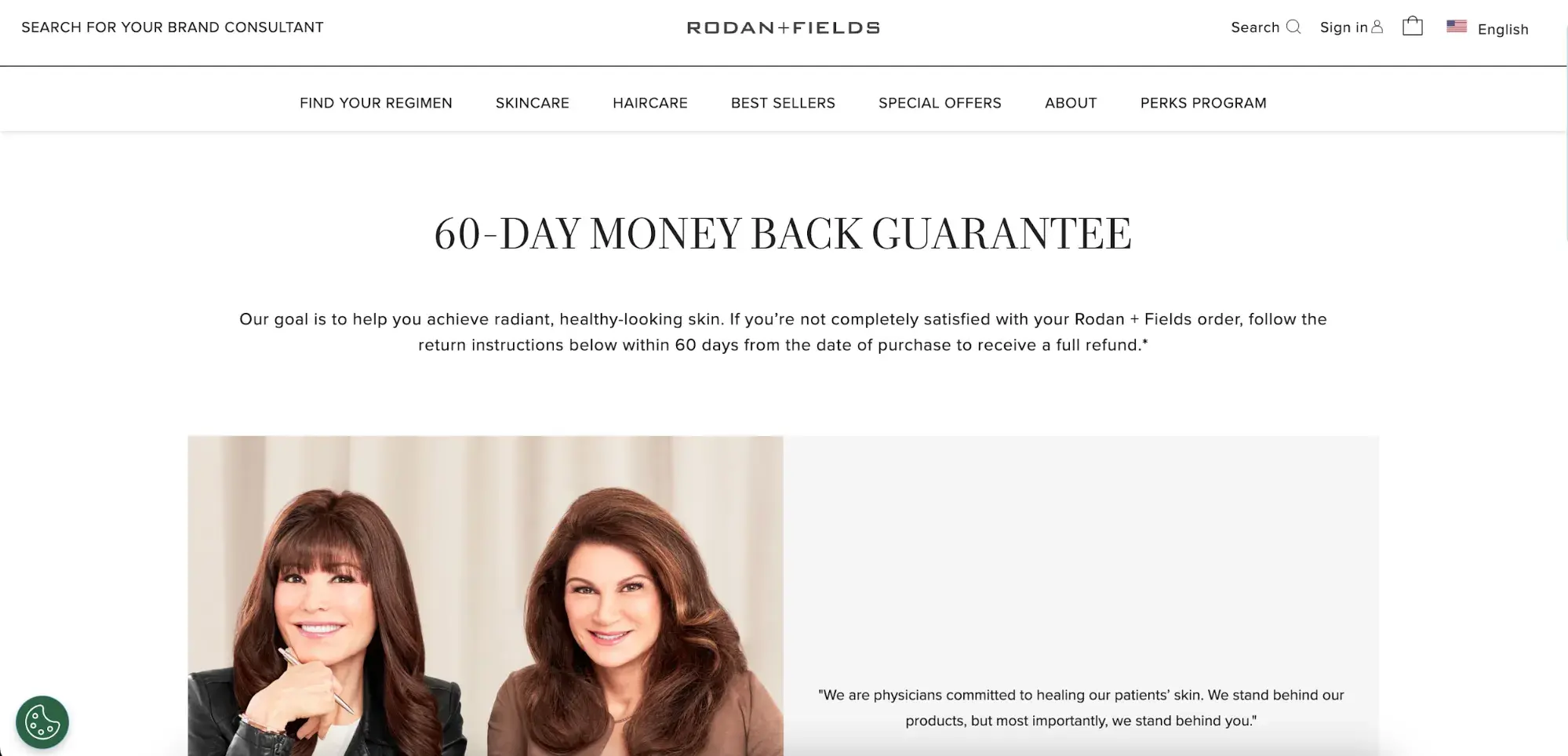
38. Improve digital accessibility.
A percentage of your target market has a disability — is your content accessible to them? One in four American adults has a disability, and these adults often hit digital roadblocks that prevent them from being able to access content online.
Some of the most common accessibility oversights that I see online are:
- Demo videos without closed captioning.
- Product images without alternative text.
- Poorly marked links and buttons.
Read our guide to learn more about website accessibility and make your site accessible to all visitors.
39. Show your values.
The most powerful thing a business can do is make customers fall in love with them. Company values have a huge impact on this. When customers feel a company is doing something ethical with their profits, they're oftentimes willing to:
- Pay slightly more.
- Endorse a company.
- Repeat their business.
Statistic: 82% of shoppers prefer that a company's values align with theirs.
Remember the deodorant company I mentioned? After months of seeing ads for Nuud, I finally made a purchase. It was natural, vegan, packaged in sugarcane, not tested on animals, and effective.
It was also more expensive, but the paid advertising convinced me to try, and it paid off for the company. I've been a loyal customer ever since, and I recommend it to friends and family every time deodorant comes up in conversation because I believe in the mission.
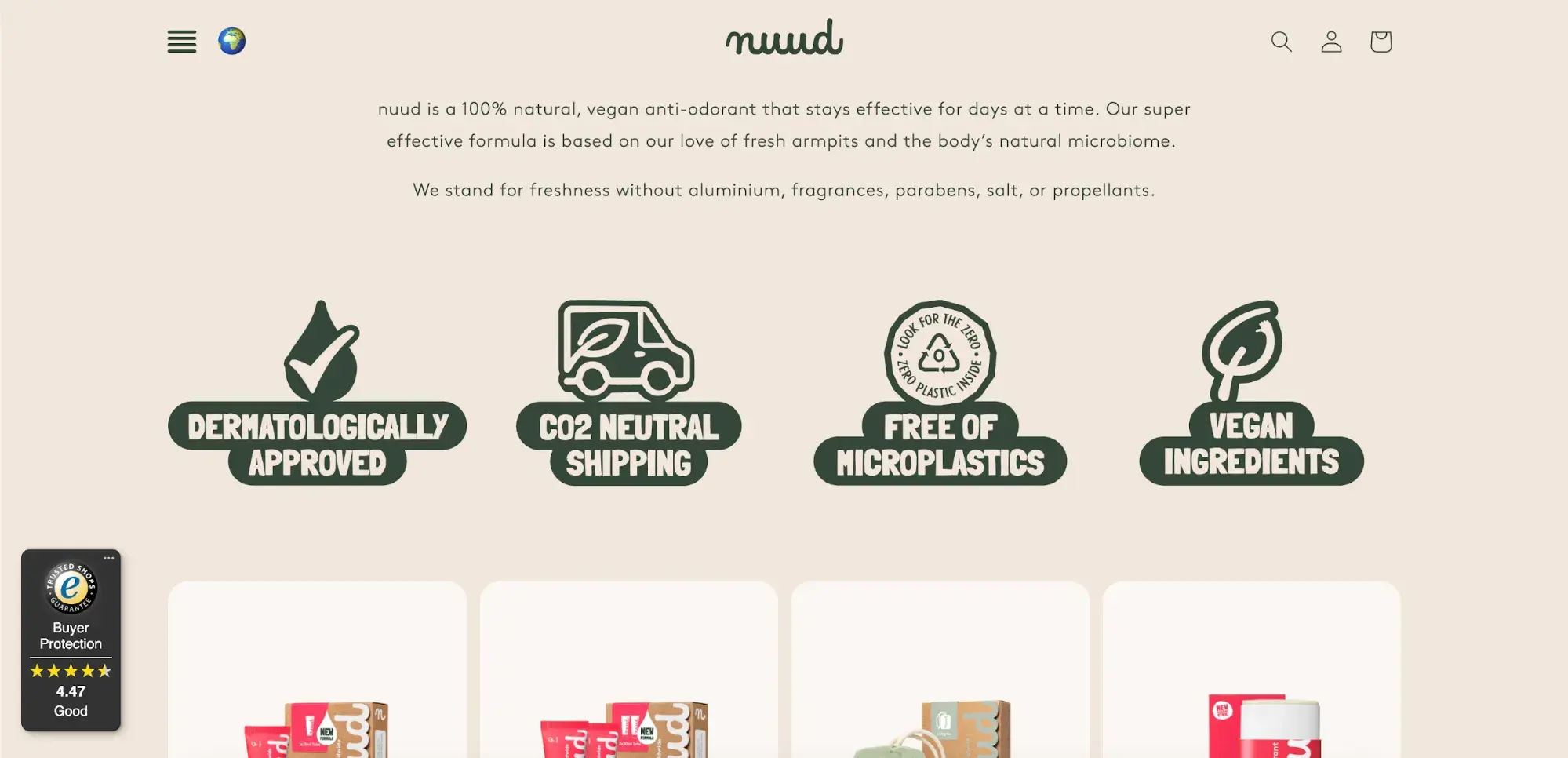
Making the Most of Your Money
If you started researching how to reduce customer acquisition cost thinking that there was one simple answer, you can see that you were mistaken. There are nearly endless ways to get more brand awareness and convince viewers to buy from you.
These techniques can cost a lot of money, but my favorite ideas are the creative (like the balloon sidewalk pop-up) and free (like the license plate) ideas that can lead to the most unexpected marketing success. Which technique will you try next?
Customer Acquisition
.png?width=112&height=112&name=Image%20Hackathon%20%E2%80%93%20Vertical%20(85).png)

.png)

![7 Customer Acquisition Challenges You Might Face This Year [New Data]](https://53.fs1.hubspotusercontent-na1.net/hubfs/53/customer%20acquisition%20%20(1).webp)



